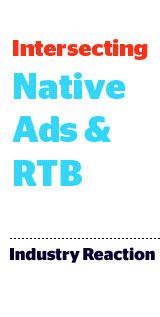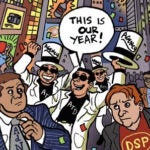 By all accounts, real-time bidding is quickly overtaking the remnant inventory business once controlled by display ad networks – next stop, the guaranteed display business.
By all accounts, real-time bidding is quickly overtaking the remnant inventory business once controlled by display ad networks – next stop, the guaranteed display business.
Concurrently, “native advertising” popularized by Facebook’s news feed advertisements, has bubbled up. But, as Magna’s Brian Monhan told AdExchanger back in June, we’re not necessarily talking about something new since “the most effective advertising has always been native to the environment in which it appears.” Nevertheless, native is “in” as marketers and their agents are determined to unlock Facebook’s enormous reach and frequency.
So, we asked a group of industry executives to provide their thoughts on the following:
“How do native advertising and real-time bidding meet?”
Click below or scroll for more:
- Ari Paparo, SVP, Product Management, AppNexus
- Darren Herman, Managing Director, kbs+p Ventures
- Tony Katsur, Chief Operating Officer, Maxifier
- Bill Wise, CEO, Mediaocean
- Marc Grabowski, COO, Nanigans
Ari Paparo, SVP, Product Management, AppNexus
“Native Advertising has been around for a hundred years, it was just called sponsorships until recently. What’s different now is that creative units are being customized for individual media properties (Twitter, Facebook, Yelp, etc) at scale and using technology. The challenge to marketers with Native is that scale to the media company might still mean a relatively small portion of the budget, and the overhead associated with gaining expertise in each Native Platform can dwarf the ROI. By allowing the scale RTB technologies to gain access to Native media, a big hurdle is potentially overcome and demand can be aggregated more efficiently from a wider variety of buyers.”
Darren Herman, Managing Director, kbs+p Ventures
“Native Advertising is quite the buzzword these days. Native advertising, IMHO can be defined as advertising engagements (sometimes units) that takes place utilizing the technology and the platform on which it exists upon and is in the natural flow of how the user interacts with the platform. If these units, subject to be different on any platform, contain something standardized that could be transacted through RTB, then we’ll see some of these units flow into auction based inventory sources such as public and private exchanges. I think that for the short term, we’ll see marketers using retargeting and re-messaging against native advertising units to continue the marketing dialogue with the consumer as this is much easier to deploy and a quick win.”
Tony Katsur, Chief Operating Officer, Maxifier
“Native advertising creates an entirely new, but welcome set of challenges for the entire ecosystem, from creative agency to RTB platforms to publishers. While RTB and native ads are currently juxtaposed, it’s not a question of how the two come together, it’s a question of when. Due to the heavy contextual and site specific nature of the native format, several more page and creative level variables must be incorporated into today’s RTB engines. Publishers will also require even more control over the native format as it takes on an “advertorial” element. This format will also provide publishers an entirely new set of variables against which they can optimize not only campaigns, but also content, thus enriching the advertising experience for both user and marketer. To expedite the integration of native into the RTB world, standards need to be set across the ecosystem, either organically or through a governing entity such as the IAB or OpenRTB. In the meantime, I see native living in the direct sold world between agency and publisher on a guaranteed basis. Once native has achieved significant scale from a revenue or volume perspective, we will see focus on the aforementioned challenges to support this format in RTB.”
Bill Wise, CEO, Mediaocean
“The potential of native ads as an engagement tool can’t be understated. But native ads also create a whole new set of tasks for media teams to manage—which can mean workflow hurdles that can keep the new formats off of media plans altogether.
Some native ad formats provide such enormous reach they can’t be ignored, regardless of workflow headaches (search advertising in its early, highly manual days is a good example). But in most instances, new ad formats don’t come with huge audiences built in, and the ad format won’t take off unless there’s automation to make it efficient at scale.
RTB is one piece of that necessary automation. But there are a lot of other pieces of the puzzle—from creative management, to addressing the apples-to-oranges issues that of fitting unique ad formats into a broader marketing plan (“How many Facebook interactions is worth one display ad?” is a well-known example of the latter).
To make native ad formats work, all the pieces of automation need to be in play—RTB, but not just RTB. Falling short of getting all the automation right is essentially barking up the wrong tree—and it’s serving up the wrong inventory, to boot.”
Marc Grabowski, COO, Nanigans
“Real time bidding and native advertising will meet when two conditions are recognized: First, the value of using the bid tool must be accretive to the native advertising performance without destroying scale. Second, publishers will need to see revenue lift from allowing native ads to enter RTB enabled marketplaces.
It is important to distinguish between an inventory selection tool and a content programming model. RTB is an instrument designed to assess a user’s value at a given time, whereas native advertising is the publishing strategy enabling advertisers to promote their content in endemic experiences while (potentially) adding value to the user.
Native advertising is especially effective when implemented in emerging ad formats similar to the inclusion years ago in video or how Facebook is currently leveraging Sponsored Stories in the mobile News Feed experience. When an ad format is part of a user’s organic experience, they are most likely to engage with the advertiser’s message. Native ads are the upper echelon of contextual relevance and can only be enhanced when the contextually relevant message is also personally relevant to the user. RTB bridges contextual relevance with personal relevance.
Considering that RTB is utilized to identify potential customers, establish a bid price and target the appropriate creative based on a variety of variables, it stands to reason that adding new parameters to the inventory evaluation cycle could increase personal relevance of an ad and lift performance for the advertiser. The important consideration is whether the signals generated (and shared) from native ads will in fact help decisioning. This point varies depending on a publisher’s execution of native ads and flexibility to pass new impression attributes to RTB auction participants. When done right, ads perform better, demand across the marketplace increases, rates strengthen and the publisher continues to invest in the user experience. This builds a virtuous cycle around ad product, user experience and site monetization.”
More AdExchanger “Industry Reactions”…
- Can It Be Done? Local, Direct, Automated Ads
- The Impact Of No More Third-Party Cookie Targeting In Firefox
- House Ads – What Are They Good For?
- What is "Premium"?
- When Is A Startup No Longer A Startup?
- Why Is Procurement Necessary?
- Agency CEOs: 2013 Planning Is About Mobile Integration
- Can You Build a Brand in Programmatic Media?
- How Do Native Advertising and Real-Time Bidding Meet?
- Why Target The Tablet?
- The Publisher Impact Of Facebook Exchange And Ad Network
- Agencies Upbeat on Tying Facebook to Cross-Channel Ads
- Are Advertisers Living the Dream of Unified Marketing and IT?
- What Next For Yahoo?
- What Counts as 'Scale' in Hyperlocal? Mobile Ad Players Weigh In
- Facebook Buys Instagram – What’s In It For Ads?
- Are Ad Servers Specifically For Publishers Or Advertisers Still Necessary?
- How Will The iPad 3 Impact Audience Buying Available Through The iPad?
- Will The Merger Of DDS And MediaBank Into Mediaocean Benefit Media Buying?
- Will SSPs and Ad Networks Sell Publisher Inventory Through DoubleClick Ad Exchange?
- The Industry 'Take' On SAS Acquiring aiMatch
- Industry Impressions Of Facebook Display Advertising
- What Are The Hurdles In Cross-Digital, Audience Buying?
- When Is A Mobile, Private Exchange Relevant To A Marketer's Needs?
- Your Ad Server, My Ad Server: Trends With Discrepancies Today
- The Opportunities Ahead For New Yahoo! CEO Scott Thompson – Industry Reaction
- Predictions 2012
- Industry Reaction: Adobe Acquires Efficient Frontier
- Yahoo! Requiring RMX Seats For DSP Advertisers
- Yahoo!, Aol And Microsoft Pool Their Premium, Non-Guaranteed Display Inventory
- Whats The Biggest Challenge With Platform Buying In Digital Today?
- Industry Reaction: Yahoo! Acquires interclick For $270 Million
- How Important Is -First Look- At Inventory?
- Where Does The Tablet Fit In The Marketer Media Plan?
- MediaBank-DDS Merger Industry Reaction: Questions Remain About MediaOcean
- Is An Online GRP Needed For Online Video Advertising?
- What Should Yahoo Do Next?
- What Solutions Are Still Needed For The Premium, Digital Publisher of Today?
- How Do Search Marketers Overcome The Creative Challenge In Graphical, Display Advertising?
- What Is The Difference Between A Social Display Impression And A Regular Display Impression?
- Is Audience Buying Possible In Mobile Advertising?
- What Are The Key Metrics For Brand Awareness Campaigns In An Automated Buying Environment?
- What Is The Biggest Challenge With The Demand-Side Platform Model?













